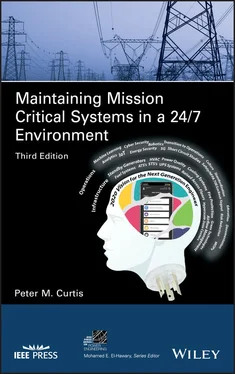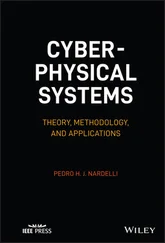7 Chapter 11Table 11.1 Differences between Precision and Comfort CoolingTable 11.2 Issues surrounding the use of Airside Economizers
8 Chapter 12Table 12.1 Table of PUE and DCiE efficiencies.Table 12.2 Data Center Cooling Best PracticesTable 12.3 Scenario 1 – Data center overheating but has adequate cooling capacit...Table 12.4 Scenario 2 – Data center overcooled but still has hotspots
9 Chapter 13Table 13.1 Panel Load ChartTable 13.2 Load calculation table for electronic pallet jack
10 Chapter 14Table 14.1 Most Common Solutions Used in Li‐Ion CellsTable 14.2 NFPA standards that govern applications of fire protection technologi...Table 14.3 Heat Detector Spacing Reduction Based on Ceiling HeightTable 14.4 Advantages and Disadvantages of Sprinkler SystemsTable 14.5 Advantages and disadvantages of double‐interlock pre‐action water ...Table 14.6 Advantages and Disadvantages of IG‐541Table 14.7 Advantages and Disadvantages of IG‐55Table 14.8 Advantages and Disadvantages of HFC‐22eaTable 14.9 Advantages and Disadvantages of HFC‐125Table 14.10 Advantages and Disadvantages of FK‐5‐1‐12Table 14.11 Advantages and Disadvantages of HFC‐23
11 1Table A.1 Key Points of Sarbanes‐Oxley Act (SOX)Table A.2 CIP‐002 through CIP‐009 Cybersecurity frameworkTable A.3 Basel II Compliance Benefits
12 3Table C.1 Average maximum inlet temperature per loadTable C.2 Temperatures about the mean value per loadTable C.3 Temperature spread based on the Standard deviation
1 Chapter 1 Figure 1.1 Hidden Costs of Operations Figure 1.2 Typical screenshot of Smart WALK™ dashboard Figure 1.3 Smart WALK™ mobile screenshot Figure 1.4 Screenshot of Smart TEAM® Learning Management System
2 Chapter 2 Figure 2.1 US Primary Energy Sources. Figure 2.2 Number of Breaches and records exposed from 2005 to 2019 Figure 2.3 Fuel Sources for Electricity Generation in the U.S. in 2018 Figure 2.4 Potential Causes of Load Interruption or Downtime Figure 2.5 The Tiers of the Electric Grid from Generation to Chip. Derived f... Figure 2.6 Solar Flare. Figure 2.7 EMP Waveform – MIL‐STD‐461G Test Method RS105 Figure 2.8 RS105 Transient Generator and Transmission Line Figure 2.9 Damped Sinusoidal Transient – MIL‐STD‐461G Test Method CS1116 Figure 2.10 Smart WALK™ mobile device Figure 2.11 The Smart Grid Network and its features.
3 Chapter 3 Figure 3.1 “Seven steps” is a continuous cycle of evaluation, implementation... Figure 3.2 Sample SCS Screenshot Figure 3.3 Sample TCC Curve Analysis Figure 3.4 Traditional AC Distribution Figure 3.5 DC Distribution Figure 3.6 Electronic Ballast Figure 3.7 Absorption Chiller Figure 3.8 Typical Fuel Cell Figure 3.9 Microturbine CCHP System Figure 3.10 DC Monitoring Equipment Figure 3.11 Smart TEAM ™ mobile screenshot Figure 3.12 Open rear door of containerized Data Center
4 Chapter 4Figure 4.1 Theory of Predictive MaintenanceFigure 4.2 Hazard Risk Category (HRC) Arc Rating (Reference of Chicago Prote...Figure 4.3 Arc Flash BoundariesFigure 4.4 A small thermographic camera and a typical installationFigure 4.5 Sample IR scanning tracking
5 Chapter 5Figure 5.1 GeneratorFigure 5.2 Load Bank TestingFigure 5.3 Generator Control Cabinet
6 Chapter 6Figure 6.1 Basic installation practices for all tanks, whether aboveground o...Figure 6.2 Typical fuel storage and distribution system flow diagram.Figure 6.3 Poorly arranged system.Figure 6.4 System using the same components as in Figure 6.3 but arranging t...Figure 6.5 System using individual components to prevent a single point of f...Figure 6.6 System that further increases reliability by adding redundancy fo...
7 Chapter 7Figure 7.1 Break Before Make ATSFigure 7.2 Basic ATS EnclosureFigure 7.3 Break Before Make ATS with Isolation BypassFigure 7.4 ATS Enclosure Equipped with Isolation BypassFigure 7.5 Closed Transition ATSFigure 7.6 Closed Transition ATS with Isolation BypassFigure 7.7 Closed Transition ATS EnclosureFigure 7.8 Delayed Transition ATSFigure 7.9 Delayed Transition ATS with Isolation BypassFigure 7.10 Delayed Transition Transfer Switch EnclosureFigure 7.11 Soft Load Power Transfer Switch
8 Chapter 8Figure 8.1 Typical Static Switch One Line
9 Chapter 9Figure 9.1 Cost of downtimeFigure 9.2 Power Factor Beer Mug AnalogyFigure 9.3 Power Factor WaveformsFigure 9.4 Typical electric systemFigure 9.5 This undistorted sine wave is also known as the fundamental wavef...Figure 9.6 Three‐phase power is produced from the rotating windings of a gen...Figure 9.7 Types and relative frequency of power quality disturbances.Figure 9.8 Example part of an IEC 61000‐4‐30 Class A Edition 3 compliance ce...Figure 9.9 Transients shown in waveformFigure 9.10 Waveforms of RMS variationsFigure 9.11 Motor‐start waveform signature.Figure 9.12 Voltage swell timeline.Figure 9.13 Unbalance timelineFigure 9.14 Notching waveformFigure 9.15 The fundamental and the 5 thharmonic.Figure 9.16 The harmonic spectrum indicating a problem.Figure 9.17 The additive effect of the triplen harmonics.Figure 9.18 Harmonic distortion waveform.Figure 9.19 Interruption timeline.Figure 9.20 CBEMA curveFigure 9.21 ITIC curveFigure 9.22 A portion of data obtained from the Distribution Power Quality M...Figure 9.23 Load problems – Power Quality Troubleshooting ChecklistFigure 9.24 Building distribution problems – Power Quality Troubleshooting C...Figure 9.25 Facility transformer and main service equipment problem – Power ...
10 Chapter 10Figure 10.1 Double Conversion: In normal operationFigure 10.2 Double Conversion: On BatteryFigure 10.3 Double Conversion: Static BypassFigure 10.4 Double Conversion: Internal BypassFigure 10.5 Typical 3‐phase Rectifier Schematic utilizing SCRs as the power ...Figure 10.6 Conventional Delta Conversion Online UPSFigure 10.7 Conventional Two‐Level inverter topology and Variable Width Puls...Figure 10.8 Three‐Level inverter topology and Variable Width Pulse TrainFigure 10.9 Silicon Valence BandFigure 10.10 SiC 73% Reduction Power LossesFigure 10.11 SiC Heat Loss Energy SavingsFigure 10.12 Diesel UPSFigure 10.13 N UPS ConfigurationFigure 10.14 N+1 UPS ConfigurationFigure 10.15 Isolated Redundant UPS ConfigurationFigure 10.16 N+2 UPS ConfigurationFigure 10.17 2N UPS ConfigurationFigure 10.18 2n+1 ConfigurationFigure 10.19 Distributed Redundant UPS ConfigurationFigure 10.20 Typical Wet Cell BatteryFigure 10.21 Typical VRLA BatteryFigure 10.22 Flooded Cell Battery RoomFigure 10.23 Cutaway of a flywheelFigure 10.24 An integrated 300 kVA flywheel/UPS
11 Chapter 11Figure 11.1 2011 ASHRAE Environmental GuidelinesFigure 11.2 Heat transfer in a simple graphical format.Figure 11.3 CRAC Unit – Illustrating the Compressors in Place within the Uni...Figure 11.4 Illustration of CRAH unit with the Chilled Water ValveFigure 11.5 Heat transfer for air‐cooled heat rejection equipment.Figure 11.6 Heat transfer for a cooling tower.Figure 11.7 Generic chiller diagram.Figure 11.8 Air‐cooled chiller diagram.Figure 11.9 Typical packaged air‐cooled chiller.Figure 11.10 Illustration of the CRAC – DX refrigeration loopFigure 11.11 Water‐cooled chiller diagram.Figure 11.12 Typical water‐cooled chiller.Figure 11.13 Schematic overview of a generic cooling tower flow.Figure 11.14 Direct cooling towers on an elevated platform.Figure 11.15 Direct of open circuit cooling tower schematic flow diagram....Figure 11.16 Indirect cooling tower schematic flow diagram.Figure 11.17 (a) Typical Ice Storage System (b) Typical Chilled Water Storag...Figure 11.18 Schematic overview of a generic air‐cooled condenser.Figure 11.19 Side inlet and side outlet, air‐cooled condenser.Figure 11.20 Bottom inlet and top outlet, air‐cooled condenser.Figure 11.21 Typical self‐contained condensing unit.Figure 11.22 Air Side Economizer Alternatives Mild Temperature OperationFigure 11.23 Air Side Economizer Alternatives Cold Day OperationFigure 11.24 Air Side Economizer Alternatives Summer/Hot Day OperationFigure 11.25 Heat wheel for data center application.Figure 11.26 Simple overview of the heat exchanger process.Figure 11.27 Shell and tube heat exchanger.Figure 11.28 Exploded isometric showing plate and frame heat exchanger opera...Figure 11.29 Installed plate and frame heat exchangers.Figure 11.30 Typical Computer Room Air Conditioning Unit.Figure 11.31 CRAC unit located outside the electronic equipment room.Figure 11.32 Downflow CRAC unit airflow path.Figure 11.33 Upflow CRAC unit airflow path.Figure 11.34 Ducted Upflow CRAC unit airflow path.Figure 11.35 Typical Hot Aisle / Cold Aisle LayoutFigure 11.36 Return Air CeilingFigure 11.37 Sealing the Hot AisleFigure 11.38 Sealing the Cold AisleFigure 11.39 Chimney Cabinets with ducting to the dropped ceilingFigure 11.40 In Row Cooling Units and the Isolation Configuration AssemblyFigure 11.41 Rear Door Heat Exchanger
Читать дальше












